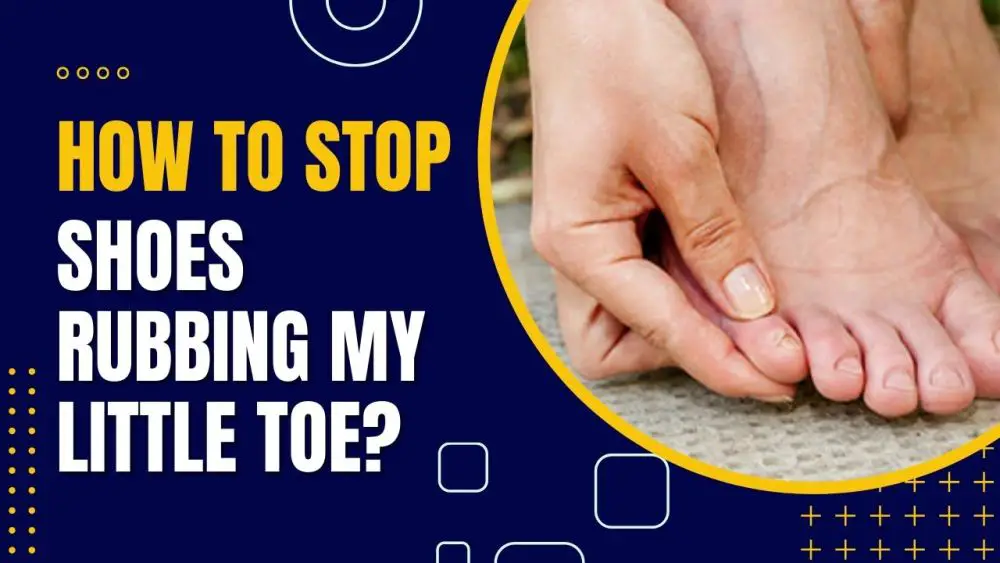Some people complain about how they trip easily when walking, or you may have yourself faced the problem: walking steadily across the street when you stumble without anything being there on the road to resist your gait.
This has an underlying reason other than just being clumsy; your toes are most likely uncomfortably positioned. If your toes are positioned badly, they eventually rub together as you move, often causing pain as well.
Now you may wonder, how can I stop the pain? You can do it if you know how to stop shoes rubbing your little toe. This rubbing can be stopped with shoes that fit, with shoes that stretch upon walking, and with flexible uppers on the shoe that allow more movement in the toe box.
If you can prevent them from rubbing, you can make your walking painless, and when you walk comfortably, there are fewer chances for you to stumble and fall. And you can save yourself from blisters on the pinky toe for good. In this article, you will learn how to prevent the rubbing of your little toe with any future shoes that you buy.
How To Stop Shoes Rubbing My Little Toe?

The first thing that can save the little toe from rubbing is to give yourself a good shoe fitting. There are other things that can prevent the discomfort as well. They are as follows:
1. Perfect Fit
Your shoes are something that should not feel too airy or too glove-like. They should feel snug on your feet. However, if you feel like they are too tight, they are going to cause rubbing amongst your toes and hurt you.
It is super important that whenever you are buying shoes, you pick the right time. Evening hours are preferably better when buying shoes because after you have done everyday work and your feet have gone through the stress and distress, your feet will eventually swell up.
With the expanded size in the equation, you will find how much room needs to be left inside your shoes to prevent the toes from being tightly jammed at the end of the day. So the size of your expanded feet will be your right size.
Also, a lot of people think that the length should be the only thing to keep in mind when buying shoes. But for the size of the feet, the width is also important. While the length of your foot will determine how long of the shoes you need, a wider shoe will help you manage a roomier toe box, hence preventing the rub.
Again, you should try wearing shoes that have no lace as these will save you from undertaking a tighter grip.
2. Powder, Inserts, and Insoles
These are stuff that you can apply to your shoes to ease the rubbing:
- Talcum powder can prevent sweat buildup in your feet which causes your toes to rub and prevent blisters.
- Anti-friction sticks cut down toe friction so apply these to your shoes.
- An anti-blister cushion worn on your little toes can protect them from rubbing.
3. Stretching
Stretching is very important when you need to stop rubbing between your toes. When you get a small shoe size in the hope that it will gradually stretch and create room for your feet to rub, you end up getting blisters, not the stretch. If you really want your shoes to stretch, you should get one that fits your feet so that it can stretch out a little. Here are some ways you can stretch shoes:
- When you have the right shoes, you need to learn to break them in. For this, simply wear them at home for some time. This will help in the stretching process.
- Another way to have them stretched is to put them in the freezer with ice.
- Wearing thick socks with your shoes also stretches them.
- If you can somehow direct steam or hot gas to the inner corners of your shoes, you can relax them and break them quicker. But don't let too hot steam destroy your shoes while doing this.
- Placing your water in shoes so that water doesn’t get in the shoes will soften the shoe and let them fit your feet naturally.
4. Flexible Uppers
You can also prevent your toes from rubbing if you have a shoe with flexible uppers. If you get shoes that are stiff on the front, the little toe will suffer the most friction of all. And to save it from this, your desired flexibility will come from shoes that have a roomier upper that stretches for your toes.
Where Should Your Toes Be In Your Shoes?
You should leave a space measuring half an inch from your big toe to the inner front end of your shoes.
So this should be about the size of the tip of your finger to the first crease. This should leave enough space for the toes in your foot whether you have a large big toe or a large Morton’s toe (which is the toe next to the big toe).
Are Your Toes Supposed To Touch Each Other?
No. Your toes are not meant to naturally stick to each other. Previously, when shoes didn’t exist and people walked barefoot, spread-out toes were much more natural as they contributed to an even distribution of body weight.
However, since we have come to wear thinner shoes with less width and have even accompanied it with socks, our toes have been trained to stick closer together than ever. This is why everyone assumes that it is more natural to have toes touching each other.
But if this positioning does not suit your toes, you can use toe spreaders to create a more natural alignment.
Why Are My Toes Rubbing Together Inside the Shoe?
The main reason why your toes are rubbing together inside the shoe is that you wear ill-fitting shoes. Other than wearing the wrong size, another reason why your toes rub could be the presence of corn or calluses, which again, result from tight shoes.
You can also have corn if you run or walk a lot in sneakers with tighter laces. So you should always get properly-sized shoes.
What Happens When Your Toes Rub Together?
Toes frequently rubbing together can cause blisters and hot spots from the irritation.
Also known as pinch blisters, these bubble-shaped bruises may be filled with water or pus-blood and can be itchy besides being painful.
Does Taping Your Toes Help To Prevent Them From Rubbing?
This method of taping your toes may or may not help you with the rubbing discomfort, it really depends. The way in which the taping helps you is that it takes the exerted pressure off the heels or balls of your foot.
When this pressure lessens, the force applied on the nerves lessens as well, making it less painful for your toes.
How To Prevent Blisters Forming On Your Toes When You Are Walking and Running?
To prevent blisters from forming, you have to stop running wearing cotton socks. Since this fabric tends to absorb sweat easily, cotton socks make a good breeding ground for bacteria and blisters to form.
So wear socks with moisture-wicking fabric or with additional powder, and make sure that the fit is right and are broken in properly.

